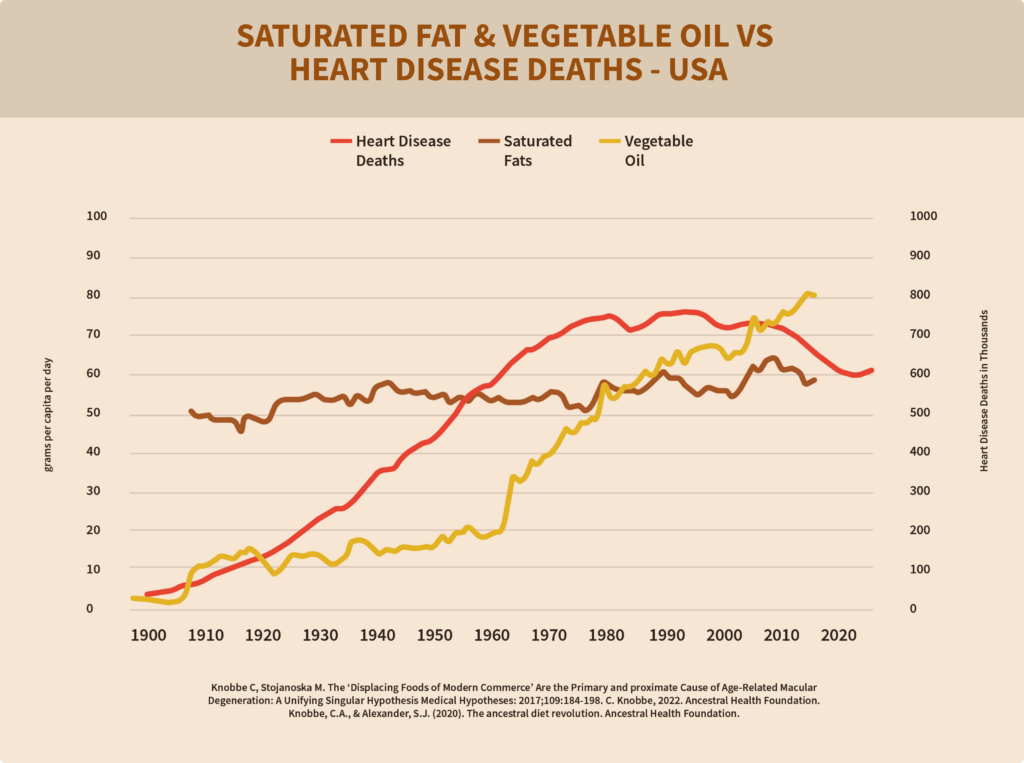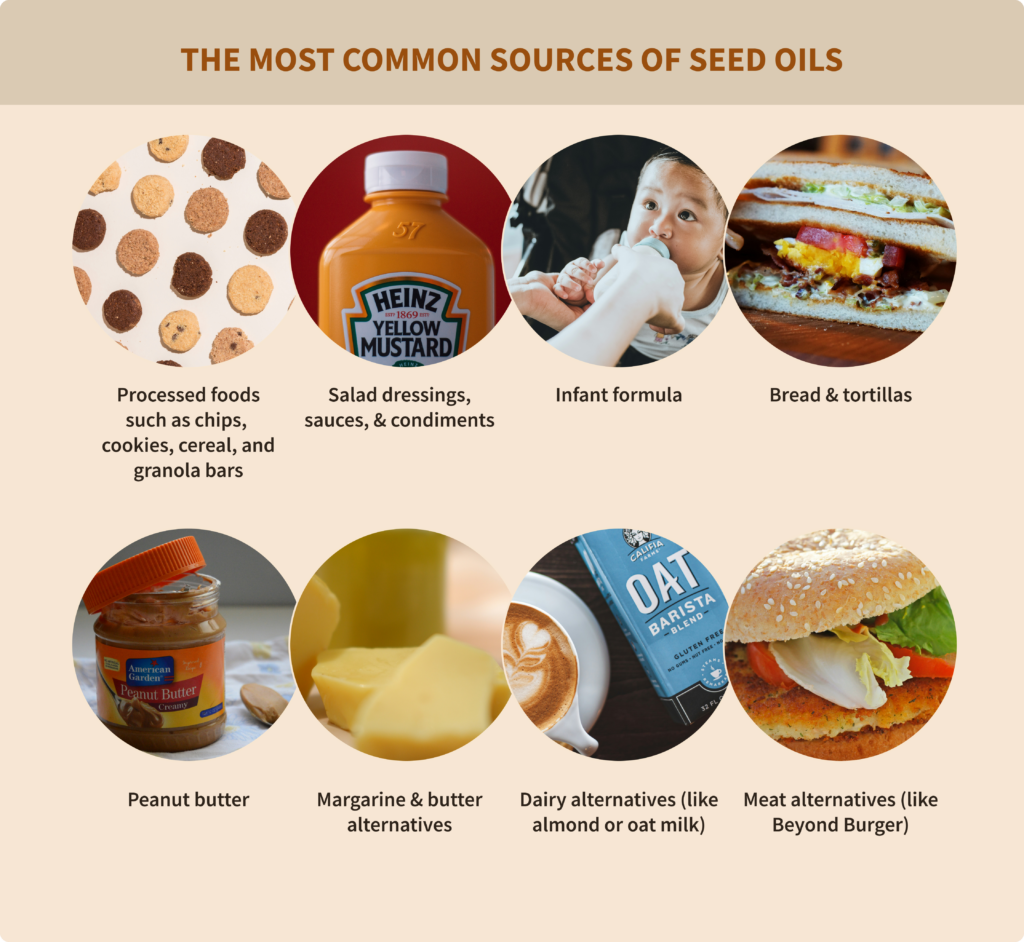In recent years, the term “seed oils” has gained unprecedented attention, making headlines in nutrition articles, the news, and even presidential campaign speeches. Seed oils include cottonseed oils, sunflower seed oil, canola oil, soybean oil, and corn oil. How did these oils become such a hot topic in our conversations about health?
To understand their controversial rise to fame and pervasiveness across our food supply, let’s explore the origins of seed oils and how they’ve become the single most significant dietary change in human history.

The Diet of Our Ancestors
For tens of thousands of years, animal fats such as butter, tallow, and lard were primary sources of dietary fat in human diets, which allowed them to thrive. Ancient societies relied on these fats’ essential nutrients like fat-soluble vitamins (A, D, E, K) and omega-3 fatty acids, crucial for various bodily functions, including brain development, immune function, and hormone regulation. During this period, rates of modern health issues like obesity and diabetes were virtually non-existent.
However, in the past century, dietary patterns shifted dramatically with a decline in animal fat consumption and a rise in the popularity of vegetable oils and processed fats. This change began during the Industrial Revolution, marking a significant turning point.
The Industrial Revolution: Cottonseed Oil
Two key developments propelled the widespread use of seed oils. Firstly, the invention of mechanical oil presses during the late 1700s and early 1800s revolutionized the mass production of industrial seed oils like flax, sesame, and cottonseed oils.
Cottonseed oil, particularly, emerged as a preferred alternative to traditional machine lubricants and lamp oil like whale oil, which were becoming scarce due to overfishing and conservation efforts. Its availability and effectiveness in machinery lubrication contributed to its widespread adoption across various industries, from textiles to transportation (1).
Secondly, in the mid-1800s, scientists began to adopt the use of solvents derived from crude oil, such as petroleum ether and hexane, to facilitate more efficient extraction of seed oils. This innovation boosted yield and broadened the applications of seed oils in industrial settings.

1900-1950s: The Rise of Hydrogenated Seed Oils
In 1900, seed oils accounted for only 1% of added fat in the American diet, but by the end of the century, they constituted approximately 85%. This dramatic shift was catalyzed by Procter and Gamble’s discovery that cottonseed oil could be hydrogenated to mimic the texture of lard, making it a viable alternative for cooking fats (2).
Hydrogenation involves adding hydrogen atoms to unsaturated fatty acids, transforming them into saturated ones, and enhancing processed foods’ shelf life and stability. Marketed under the brand name Crisco, this product quickly gained popularity nationwide (3). In its marketing campaigns, Proctor and Gamble famously touted that Crisco was “digestible.”
Procter & Gamble’s success with Crisco marked a pivotal moment in the widespread adoption of seed oils. In the 1940s, the company donated $1.7 million (equivalent to approximately $30-40 million in 2024) to the American Heart Association (AHA), coinciding with the organization’s endorsement of vegetable oils as “heart-healthy” alternatives to animal fats (4). By the mid-1900s, inexpensive hydrogenated oils such as Crisco were a staple in processed foods and baked goods.

1950-2000s: The Diet-Heart Hypothesis
In 1955, President Eisenhower’s heart attack sparked national concern. Ancel Keys, the friend of Eisenhower’s doctor, came forward with the “Diet-Heart Hypothesis.” His “Seven Countries Study” linked saturated fat to heart disease (5). Despite a lack of strong evidence, this hypothesis gained traction, prompting health authorities like the American Heart Association to recommend polyunsaturated fats from seed oils as part of a heart-healthy diet (6).
Rapeseed oil gained attention during the 1970s, although its high toxicity in large quantities prompted Canadian scientists to develop a less toxic variant called canola oil by the 1980s, coined by the Rapeseed Association of Canada (RAC). Over the following decade, they created genetically modified varieties to improve resistance to pests and herbicides, contributing to its popularity (7). Today, it’s one of the world’s most widely used cooking oils.

Seed Oils Today
Seed oil consumption has skyrocketed from about one gram per day in 1900 to a staggering 80 grams by 2018, with this trend continuing to rise. (8). These oils have infiltrated nearly every product in grocery stores, from salad dressings to coffee creamers. The widespread prevalence of seed oils in the market is driven by three main factors:
- Production Methods: Manufacturers are increasingly adopting advanced technologies to cut corners and lower production costs. Seed oils are now typically extracted through high-heat methods and chemical solvents, followed by refining processes such as bleaching and deodorizing, often with preservatives added and packaged in plastic containers.
- Economic Factors: The U.S. Department of Agriculture (USDA) oversees over 150 initiatives that provide direct subsidies and indirect support to agricultural enterprises. As a result, crops like corn, soy, and rapeseed are so heavily subsidized that their prices fall below the cost of production, reinforcing their dominance in the market. (9)
- Biased Misinformation: Persistent myths about saturated fats contribute to the widespread acceptance of seed oils. The American Heart Association labels saturated fats as “bad,” promoting alternatives like canola, safflower, and soybean oils (10). Even the USDA advises cutting back on saturated fats, including milk and beef, further perpetuating the narrative (11).
The Controversy
The prevalence of seed oils has coincided with an increase in conditions such as heart disease, obesity, and diabetes. Emerging research increasingly links seed oils to inflammation and various diseases (12). Here’s why:
- Omega-6 Imbalance: Seed oils are rich in omega-6 fatty acids, which can disrupt the balance with omega-3 fatty acids, potentially leading to chronic inflammation.
- Nutrient Stripping: The refining, bleaching, and deodorizing processes strip these oils of essential nutrients and antioxidants.
- Oxidized Fats: High-heat extraction methods can produce oxidized fats that are associated with adverse health effects.
The overwhelming consumption of these seed oils, combined with factors like lack of sleep, exposure to artificial light, sedentary lifestyles, and high stress levels, is the root cause of today’s health issues. To learn more, check out our blog post, “Are Seed Oils Bad for You?”
The Future
Dietary trends such as paleo, keto, carnivore, and animal-based diets are raising awareness about the dangers of processed seed oils, prompting some manufacturers to reduce or eliminate their use. However, there is still much progress to be made. Our mission is to return to an ancestrally consistent diet of whole foods that embraces animal fats and avoids seed oils. This is the way to radical health.
Subscribe to future articles like this:
